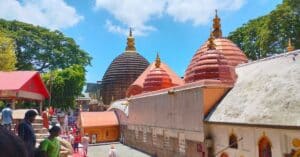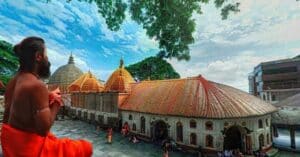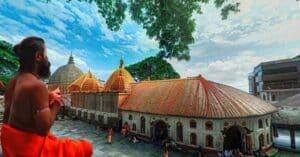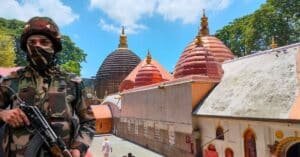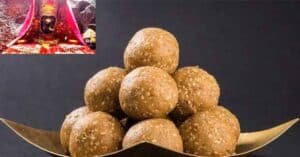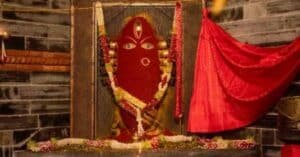The Kamakhya Temple, situated on the Nilachal Hill in the western part of Guwahati city in Assam is one of the oldest of the 51 Shakti Peethas in India. It is one of the biggest temples of Guwahati. The story of the Kamakhya temple is part of the folklore of Assam and its mythological origin is fascinating. It is to be noted that the story of Kamakhya Temple has many versions and anecdotes. We will divide the legend surrounding Kamakhya Temple into two parts: Part 1 is about Lord Shiva and Part 2 is about King Narakasur.
About Kamakhya Temple: It is the most popular temple of Guwahati. The temple complex consists of 11 temples; 1o other temples surround one main temple. The architectural layout of Kamakhya temple is mesmerising and quite advanced even by today’s standards. Engraved upon the walls of the temple are various Gods and Goddesses that add the minuteness of detailing in the architectural design.
The history behind the origin of Kamakhya Temple is reflected through the verbal tales, religious aural, folktales and various other oral traditions. The historical origin of the temple is found in various ancient texts such as Kalika Purana, Yogini Tantra, Shiva Purana, Brihadwadharma Purana etc. Here is the most popular version of the story of Kamakhya Temple of Guwahati.
Part 1: The Story of Kamakhya Temple
We all know that Lord Shiva married Devi Sati. Sati’s father, King Daksha, always thought of Lord Shiva to be good for nothing and a homeless addict. Once King Dakshya organized a big religious function (Yagya) and he invited all the Gods and Kings but not Lord Shiva. When Sati came to know about it, she went to her husband Lord Shiva to ask for his permission so she could attend her fathers Yagya.
When Sati did not get the permission from Lord Shiva. she, in rage, transformed herself into the four armed Goddess Kali, the colossal of destruction and the epitome of anger. When Lord Shiva saw the transformation of Sati into Goddess Kali, he was forced to give way to her so that she could attend the religious ceremony of her father.
Sati attended the yagya. but disaggrement ensued between Sati and his father. Out of remorse, she sacrificed her life by jumping into the Yagya fire (religious fire) . The news of Sati‟s demise made Lord Shiva very furious. Lord Shiva behaded Sati’s father king Dakshya and destroyed the whole ceremony.
Origin of The Legend of Maa Kamakhya

After the destruction, Lord Shiva full of grief carried the dead Sati on his shoulder and roamed the whole universe without having any purpose or destination. In order to bring back normalcy into the universe, Lord Vishnu with the help of his Spinning Wheel (sudarshan chakra) made fiftyone parts of her body. The places where the body parts of Sati fell were all were turned into holy, religious, places for worshiping her. It is believed that out of the fifty one body parts, one of it namely the female sexual organ fell above the Nilachal hill of Kamrup.
The grief stricken Lord Shiva after losing Sati sat for meditation. The whole universe came to a standstill . The Gods tried their best to break his meditation with the help of Kaamdev and Rati. This made Lord Shiva angry and he burnt Kaamdev into ashes with his third eye.
Later on, Lord Shiva’s life was brough back to normalcy with the help of other Gods. Shiva along with his newly married wife Devi Parvati went to Bhasmachal hill and lived happily.
Story of Kamakhya Temple : Who Built it at First?
At this juncture, Rati, the wife of Kaamdev whom Lord Shiva burnt to death, prayed and pleaded before them so that Lord Shiva could bring back Kaamdev her husband back to life. Lord Shiva agreed and brought Kamdev to life.
But Kamdev was no more that handsome which he earlier used to be. When he complained to Lord Shiva about it the Lord said-
“Kaamdev! The sexual organ of Devi Sati is secretely lying in the hills of Nilacahal. Go there, establish a temple in the anem of mahamaya/maa Kamakhya and start to publish and profess her name and significance among all people and only then will you get back the beauty you lost”
Kaamdev subsequently established the temple in the name of Mahamaya Kamakhya and professed her significance far and wide along with his wife Rati. This pleased Maa Kamakhya and she returned Kaamdev his lost beauty.
Disclaimer: This story of Kamakhya Temple of Guwahati based on mythology and folklore of Assam. There is no historical evidence to it.
Part 2: Later History and Myth About Kamakhya Temple
Just like Maa Kamakhya is associated with Lord Shiva, numerous folklore links the story of Kamakhya Temple with Mythological king – Naraka or Narakasur. According to the legend, King Naraka used to worship Devi Kamakhya, but under the influence of King of Sonitpur Bana, Narakasur quit worshipping the Goddess. He engaged himself in heinous activities like harassing the Gods and saints as well as kidnapping and torturing any women he would lay his eyes upon.
King Narak was so mesmerized by the beauty of Goddess Maa Kamakhya that he proposed her to marry him. Goddess Kamakhya put a condition that only if he build the temple and the pathway to the hilltop in one night, would she consider the proposal. King Narak was surprisingly about to complete the whole project but then just prior to dawn Devi Kamakhya took the form of a rooster and started crowing thereby reminding the king that the night was over and his work incomplete. He failed and could not marry the Goddess Kamakhya. However, the work done by the King Naraka in order to marry Kamakhya is considered to be the foundation of the temple. Just standing near the Nilachal hill is the Narakasura hill constantly reminding us his association with the Goddess.
After the incident, Narakasura prohibited the all religious and tantric practices in the temple of Kamakhya as he was deceived by the goddess Kamakhya in his attempt to marry her. These practitioners of tantricism then shifted to Mayong village and the village flourished as a center of black magic in Assam.
Disclaimer: Again, this story of Kamakhya Temple of Guwahati based on mythology and folklore of Assam. There is no historical evidence to it.
But Who Built the Kamakhya Temple?
The initial construction of the Kamakhya temple is shrouded in mystery and legends. No One knows from which period the temple existed and who built it. If we have to believe the legends and myth, the construction of the Kamakhya temple goes to Kaamdev, then to King Naraka.
However, these stories of kamakhya temple are based on Kalika Purana and other religious texts who cannot be classified as authentic history.
What about historical evidences and written records?
First recorded written history regarding constriction of Kamakhya temple is during the Koch dynasty of Assam. As it was said earlier, the temple temple existed since ages without any evidence of written records of who built it and when. It was in between 1515 to 1580 AD that the Kamakhya temple was rebuilt by Koch King. It was again destroyed during Hussein Shah’s invasion of the Kamata kingdom and then it was King Naranarayan (son of King Biswasingha) who rebuilt it once again in 1565 and it is been standing ever since.
FAQ and Mythbusters : The Story of Kamakhya Temple
Q: What is so special about Kamakhya Temple of Guwahati?
A: The Kamakhya temple represents many things in one. It represents the earliest form of Hinduism prevalent in Northeast India even before the arrival of Aryans. It is famous for tantricism, aghori cult, yoni worship, animal sacrifices etc. Above all, it is considered the supreme deity in Assam and Northeast India.
Q: Who built the famous Kamakhya Temple of Guwahati?
A: The correct answer is no one exactly knows who built it and when. It has been there since pre-historic times. However, the correct structure was built by King Naranarayan of Koch dynasty in the year 1565 AD.
Q: Is it true that Men are not allowed inside Kamakhya temple?
A: No it is not. Generally, all person without discrimination is allowed inside the temple. However, it is to kept in mind that the temple exists because the female sexual organ (yoni) of Goddess Sati fell on the place of the shrine. It is during the ambubasi mela, a three-day long ban is imposed on visiting the shrine as people believe the Goddess menstruates. During these three day, only female priests or sanyasis are allowed to serve the temple during those days.



